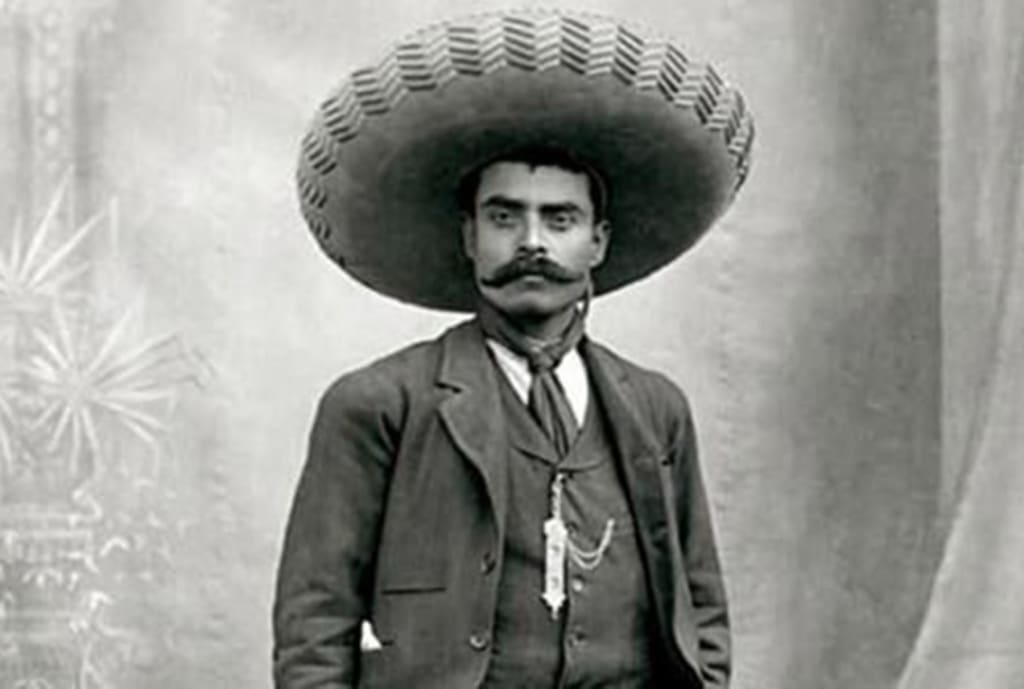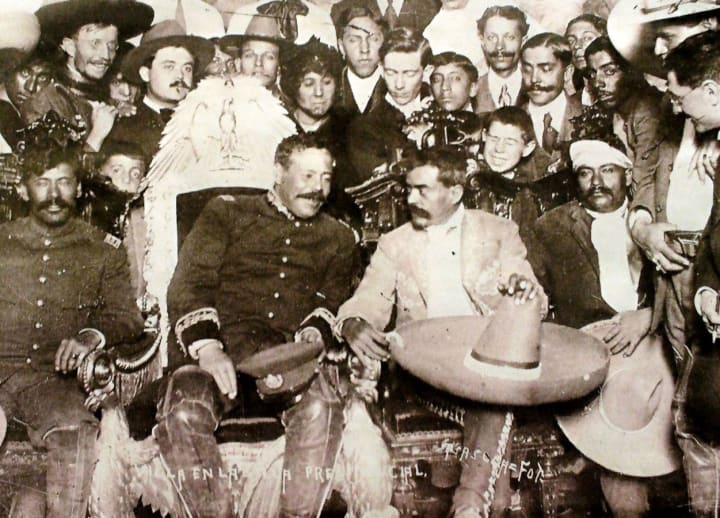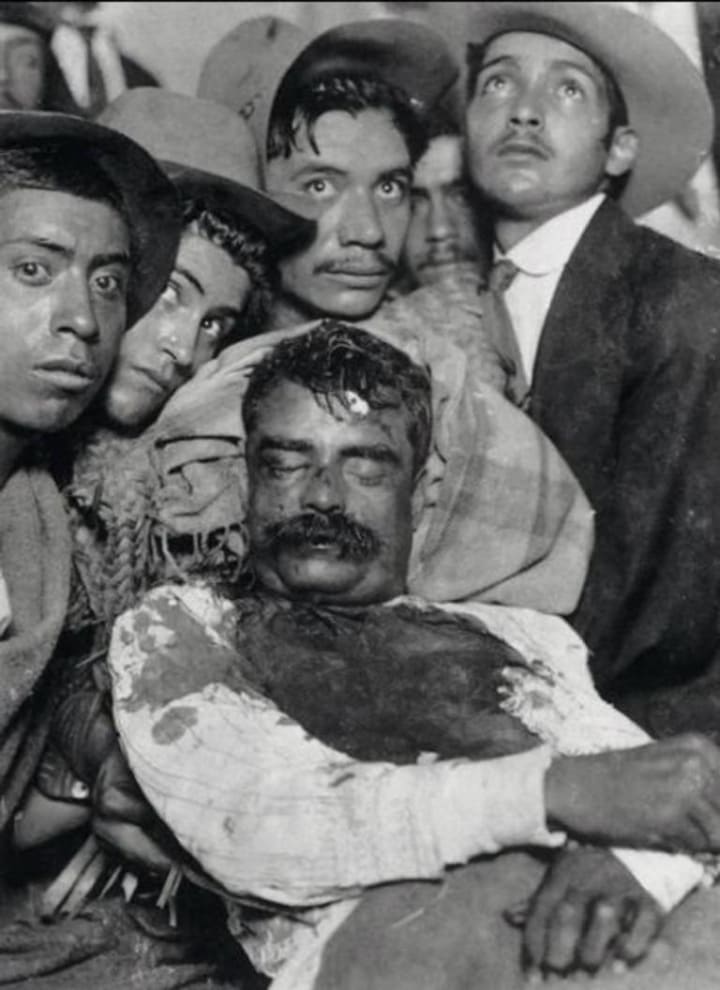Who was Emiliano Zapata?
emiliano zapata biography

Emiliano Zapata Salazar was born on August 8, 1879 in Anenecuilco, Morelos, Mexico. His parents were Gabriel Zapata and Cleofas Salazar. He had six sisters (Celsa, Ramona, María de Jesús, María de la Luz, Jovita and Matilde) and three brothers: Pedro, Eufemio (who also reached the rank of general in the Revolution) and Loreto. His maternal grandfather, José Salazar , militated in the army of José María Morelos y Pavón during the siege of Cuautla; His paternal uncles Cristino and José Zapata fought in the Reform War and in the French Intervention under the orders of Generals Carlos Pacheco and Porfirio Díaz.His childhood was developed in the context of Porfirian landlordism in Morelos. He did his first studies with Professor Emilio Vara, who had been an old Juarista soldier. At the age of nine, upon witnessing the dispossession of land from peasants caused by landowners in the area, and after hearing his father tell her that nothing could be done, he enthusiastically and courageously told her.
He was 16 years old when his mother died, 11 months later he lost his father. He soon worked as a farmer and muleteer. On June 15, 1897, he was apprehended by the rural forces of Cuernavaca, during the town festival of Anenecuilco. His brother Eufemio managed to get him released, gun in hand. For this reason, the Zapata brothers left the state. Emiliano spent a year working on the Jaltepec farm in Puebla.
first political forays

On September 12, 1909, Emiliano Zapata was elected calpuleque (Nahuatl word, which means chief, leader or president) of the Anenecuilco-Villa de Ayala-Moyotepec Land Defense Board where he would begin to analyze documents that originated in the viceroyalty that accredited the property rights of the peoples over their lands, which had been denied by the Reform Laws, especially the Lerdo Law that forced civil corporations to sell or expropriate unproductive lands, which was the reason in his time of the support of various indigenous leaders such as Tomás Mejía to the Mexican conservative governments and the Second Mexican Empire. These laws were also used by several people to increase their lands illegally by requesting ownership of communal areas that the towns did not work. Because of this, he would become an agrarian leader in Morelos, his home state.
In February 1910 he was forcibly incorporated into the Ninth Cavalry Regiment based in Cuernavaca, with the rank of the common soldier. In May of that same year, he forcibly recovered the lands of the Hacienda del Hospital, which were protected by the chief of police, José A. Vivanco, and which he left in the possession of the local peasants. For this fact, he had to escape from the government several times, because he was declared a bandit. Some months later he participated in the meeting that was held in Villa de Ayala, in order to discuss what would later become the Ayala Plan. He brought together the residents of three towns: Anenecuilco, Villa de Ayala, and Moyotepec.
Mexican Revolution

When Francisco I. Madero proclaimed the Plan of San Luis, which marked the beginning of the Revolution of 1910, Zapata read a copy; The third article especially called his attention, which offered the restitution of the lands to their "former owners." Emiliano Zapata held talks with Pablo Torres Burgos, an influential rural teacher, and with Gabriel Tepepa, Catarino Perdomo and Margarito Martínez. An agreement was reached that Torres Burgos, who was the most educated of the group, would meet with the Chief of the Revolution, Francisco I. Madero, in San Antonio, Texas.
After this interview they decided to take up arms Pablo Torres Burgos, Emiliano Zapata, Rafael Merino and about 60 peasants, among whom were Catarino Perdomo, Próculo Capistrán, Manuel Rojas, Juan Sánchez, Cristóbal Gutiérrez, Julio Díaz, Zacarías and Refugio Torres, Jesús Becerra, Bibiano Cortés, Serafín Plascencia, Maurilio Mejía and Celestino Benítez: on March 10, 1911, meeting during the Lenten fair in the city of Cuautla, they proclaimed the Plan of San Luis. Zapata headed south, as he was already being pursued by Aureliano Blanquet and his battalion of soldiers. In this period of the Zapatista movement, the battles of Chinameca, Jojutla, Jonacatepec, Tlayecac and Tlaquiltenango stand out, as well as the death of the Zapatista and former leader of the Suriano movement, Pablo Torres Burgos, who even preceded Emiliano himself. Upon his death, Emiliano Zapata was elected by the revolutionary junta of the south, on March 29, 1911, as the new revolutionary chief of Madero in the south. The Zapatista demands (which would be contained in the Ayala Plan of November 1911) entailed a radical agrarian reform —"The land belongs to those who work it", a phrase by Teodoro Flores, father of the Flores Magón brothers, which would become a motto of his unacceptable fight for the successors of Porfirio Díaz. The same can be said of Francisco León de la Barra who, making use of his power as president, led various political and armed confrontations with the Suriano chief, and even of Francisco I. Madero himself.
Emiliano Zapata establishes his headquarters in Cuautlixco, a town near Cuautla. From there he directed the attack on the Porfirista Army, defended by the 5th Regiment, under the command of Colonel Eutiquio Munguía; in addition to a Rural Corps, under the command of Commander Gil Villegas. On March 29, Zapata assumed command of the revolutionary forces that at that time consisted of about a thousand men. On April 2 he took Huehuetlán, Puebla, and managed to take the city on May 13, 1911.
On November 25, 1911, Zapata launched the Plan de Ayala, drafted by Otilio E. Montaño, a document that would become his banner and a faithful example of the ideology of the Morelos peasants. It demanded the redemption of the indigenous people and the distribution of the large estates created during the Porfiriato. Francisco I. Madero was unknown as president and Pascual Orozco was recognized as the legitimate leader of the Mexican Revolution. This document would be transformed after the uprising of Victoriano Huerta by the different ideologies (many of them influenced by Ricardo Flores Magon), and later defended by Zapata in the Aguascalientes Convention. The intellectuals who dedicated themselves to modifying the Ayala Plan, in which Madero and Huerta were unknown as presidents; and Orozco, as leader of the revolution; They were in charge of making clear the social character of the movement, and also rectified the concept of 'class' within Mexican society. Arturo Felipe Ávila Espinosa (Historian of the UNAM Institute of History) says:
They put on the table fundamental political issues that had not been addressed or that had been ignored by the other currents, such as the legitimacy of the Revolution, the representation of popular sovereignty in a revolutionary era, the responsibility of the revolutionary currents, the need to its unification for the formation of a new government and the call for a Convention of all its heads to constitute the national government. These remarks enriched the political debate between the currents and indicated a possible route of convergence between them. But, in addition, another characteristic that distinguished Zapatismo was the emphasis with which it defended the social content of the Revolution, its stubbornness in attributing to it a sense of transformation and reform of institutions for the benefit of the majority and excluded popular sectors
During 1912, Emiliano Zapata fought the Federal Army that, under the command of generals Arnoldo Casso López, Juvencio Robles and Felipe Ángeles, sought pacification in the southern states. The Zapatistas sought to defend themselves and they did so brutally: references to assaults, fires, and rapes, among others, are common in the narrations of the Zapatista attacks. In that year, the attacks on Tepalcingo, Yautepec, Cuautla, and Cuernavaca stand out, although it must be stated that at that time the Zapatista movement was very weak, both in the political sphere and in the military branch, especially when the campaign of the Maderista government against the surian rebels was left in charge of General Felipe Angeles. Due to their civilized and tolerant methods, they subtracted bases from Zapatismo, since Ángeles sympathized with them.
Personal life
According to the book El album de Amada Díaz written by Ricardo Orozco and based on the diaries of Amada Díaz, daughter of Porfirio Díaz, Zapata had a very good friendship with Amada's husband, Ignacio de la Torre y Mier. The friendship between the two has been questioned over time and it has been said that Zapata and Mier had a love relationship, but this has only remained a rumor. Other people who have spoken about this include Pedro Ángel Palou in his novel Zapata, in which he insinuates that he had some alleged homosexual relations, this is based on testimonies of Manuel Palafox, known as "El Ave Negra" and who was the secretary Zapata staff.
As far as is known, Emiliano Zapata Salazar had up to 16 documented children with 9 women, but there are those who say that he had relationships with 14 women.
The reason Zapata joined the army was the fact that he had kidnapped a young woman. The accusation was made by the father of Inés Alfaro Aguilar, a young woman with whom Zapata would later have five children: Nicolás, Guadalupe, Juan, Ponciano, and María Elena Zapata Aguilar. In the photograph in which Zapata appears next to General Pancho Villa seated in the presidential chair, the youngest child who appears is Nicolás. By November 3, 1943, only Nicolás was left alive, according to a document signed by Inés Alfaro Aguilar.
Also according to historian Jesús Sotelo Inclán, Zapata married a wealthy young woman named Luisa Merino, although this statement is not universally accepted.
When the Porfirista dictatorship fell, on August 20, 1911, he married Miss Josefa Espejo Merino known as "La Generala" (San Miguel de Anenecuilco, Wednesday, March 19, 1879 - Villa de Ayala, Friday, August 8, 1968) , daughter of Don Fidencio Espejo and Guadalupe Sánchez Merino, with whom he had two more children. The first, a man named Felipe Zapata Espejo, was born around 1912 on El Jilguero hill and died at the age of five, around 1917, in one of the many shelters they had as a family, after being bitten by a rattlesnake. The second child was a girl, Josefa Zapata Espejo, born around 1913 in Tlaltizapán and who died a year before Felipe, around 1916, as a result of a scorpion sting.
Murder

The war by the government took ruthless profiles in the north. Gonzalista Jesús Guajardo led Zapata to believe that he was dissatisfied with Carranza and would be willing to join him. Zapata asked for evidence and Guajardo gave it to him by shooting approximately fifty federal soldiers, with the consent of Carranza and Pablo González, and offering Zapata weapons and ammunition to continue the fight. Thus, they agreed to meet at the Hacienda de Chinameca, Morelos, on April 10, 1919. Zapata camped with his forces outside the farm, and approached it accompanied only by an escort of ten men. Crossing the lintel, an orderly stationed at the entrance blew his bugle for honors. That was the signal for the shooters, hidden on the rooftops, to open fire on Zapata, who managed to pull out his pistol, but a bullet knocked it down; then the caudillo fell dead. Not a few condemned the procedure. In addition, this led to the fact that, once he died from more than twenty shotgun wounds to the body, Zapata became the propagator of the revolution and a symbol of the dispossessed peasants. The movement continued, although with less intensity, and the Zapatistas agreed to name Gildardo Magaña Cerda head of the Liberation Army of the South. He would be the last, because almost a year later, Zapata's former comrades would join the Aguaprietista government, although some of them would be assassinated by the same government.
About the Creator
diego michel
I am a writer and I love writing






Comments
There are no comments for this story
Be the first to respond and start the conversation.